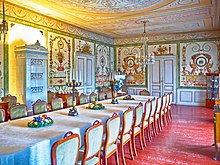Elisabeth of Great Britain, Ireland and Hanover

Princess Elisabeth of Great Britain and Ireland (born May 22, 1770 in Buckingham Palace in London , † January 10, 1840 in Frankfurt am Main ) was a member of the House of Hanover and, by marriage, Landgrave of Hesse-Homburg .
Life

youth
Princess Elisabeth was the third daughter of the British King George III. (1738-1820) and his wife Princess Sophie Charlotte of Mecklenburg-Strelitz (1744-1818), the second daughter of Prince Karl (Friedrich Ludwig) of Mecklenburg and his wife Princess Elisabeth Albertine of Saxony-Hildburghausen . She was the younger sister of the later kings George IV , Wilhelm IV and Ernst August I , as well as the aunt of Queen Victoria .
Landgrave of Hessen-Homburg
Eliza, as she was called, had little interest in the stiff court etiquette; she was spirited and resolute and longed for her own household. There were also rumors at court of a secret wedding and two illegitimate children who are said to have arisen from this connection. Furthermore, she was interested in painting since her youth and enjoyed training as a draftsman and engraver. She also had intensive contact with court painters such as Benjamin West , Thomas Gainsborough and William Beechey as well as the engraver Francesco Bartolozzi . That Princess Elisabeth, when she saw the German Hereditary Prince Friedrich von Hessen-Homburg in his Austrian hussar uniform, is said to have said: “If he is single, I will marry him!” Is an anecdote. In fact, the wedding had been planned well in advance. Initially, Friedrich showed no tendency to marry. Neither the urgent ideas of the father, who even asked for the hand of Elisabeth's older sister Augusta Sophia for his son in 1804 , nor a petition by the "people's representative authorities" of Hessen-Homburg were unsuccessful. During the Congress of Vienna , the Duke of Kent and the Hesse-Homburg ambassador Johann Isaak von Gerning established the connection. After Friedrich had been dealt with once more from all sides, he traveled to London on January 15, 1818, where he was received with open arms. On February 4th, the future groom submitted his written application and found the support of the British regent George IV. On February 17th, the engagement and on April 7th, 1818 the wedding of the Archbishop of Canterbury took place at Buckingham Palace in London . It was not a real "love marriage", despite mutual understanding and respect, it was an agreement with which both got along well. When Friedrich VI. When he came to power in January 1820, thanks to the dowry of 40,000 thalers and the annual allowance of 13,000 pounds, he had enough money to reorganize the Hesse-Homburg budget. Elisabeth, on the other hand, was able to say goodbye to the British court and realize herself. She had roads laid in her new home and enabled the construction of the Gothic House , took care of the restoration and conversion of the Homburg and Meisenheim castles (Wolfgangbau) and was involved in poor relief. She obtained seeds and saplings from Great Britain and monitored their yield in the Landgrave's Gardens . She also continued her artistic activities.
After her husband died unexpectedly in 1829, she lived with her small court alternately in Homburg, in Frankfurt (here at Große Eschenheimer Strasse / Zeil ), London and at the court of her favorite brother Adolph Friedrich in Hanover.
She died in her apartment in Frankfurt and is buried in the crypt of Bad Homburg Castle .
Honors
Elisabethenstrasse in Bad Homburg is named after her. In front of the English Church on Ferndinandstraße there is a listed monument by the artist Fritz Gerth , which commemorates her. This portrait bust above the plinth flanked in Baroque style by volutes shows the landgrave at a young age, dressed in the fashion of the Empire . The esteem that the Landgrave enjoyed was also evident in the fact that the unveiling took place on August 12, 1908 in the presence of Kaiser Wilhelm II and King Edward VII . Since 1995, part of her widow's apartment in the so-called English wing of Bad Homburg Castle can be viewed again .
title
- 1770–1818 Her Royal Highness Princess Elisabeth of Great Britain and Ireland
- 1818–1820 Her Royal Highness Princess Elisabeth of Hessen-Homburg
- 1820–1840 Her Royal Highness Landgrave Elisabeth von Hessen-Homburg
exhibition
- 2010: The graphic work of Landgravine Elizabeth (1770–1840). Museum in the Gothic House , Bad Homburg
literature
- Flora Fraser: Princesses - The six daughters of George III. , Bloomsbury Publishing, London 2012, ISBN 978-1-4088-3253-0
- C. Arnold McNaughton: The Book of Kings: A Royal Genealogy. in 3 volumes, Garnstone Press, London UK 1973.
- Greta Walsh: Remarkable women in Homburg. Women shape 300 years of Bad Homburg history. Kramer, Frankfurt, ISBN 3-7829-0456-7 .
- Gerta Walsh: love stories in Bad Homburg. Societäts-Verlag, Frankfurt, ISBN 3-7973-0905-8 .
- Alison Weir: Britain's Royal Family: A Complete Genealogy. The Bodley Head, London UK 1999.
Web links
- Elizabeth Hanover, Princess of the United Kingdom on thepeerage.com , accessed October 4, 2015.
- Hessen-Homburg, Elisabeth Landgravine of. Hessian biography. (As of January 21, 2020). In: Landesgeschichtliches Informationssystem Hessen (LAGIS).
Individual evidence
- ↑ State Office for the Preservation of Monuments Hesse (ed.): Monument Landgräfin Elisabeth In: DenkXweb, online edition of cultural monuments in Hesse
| personal data | |
|---|---|
| SURNAME | Elisabeth of Great Britain, Ireland and Hanover |
| ALTERNATIVE NAMES | Elisabeth of Hanover |
| BRIEF DESCRIPTION | Member of the House of Hanover and, by marriage, Landgrave of Hessen-Homburg |
| DATE OF BIRTH | May 22, 1770 |
| PLACE OF BIRTH | Buckingham Palace , London |
| DATE OF DEATH | January 10, 1840 |
| Place of death | Frankfurt am Main |

